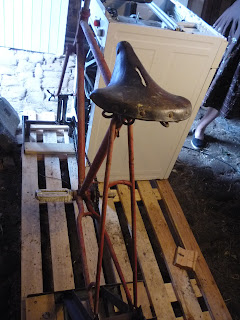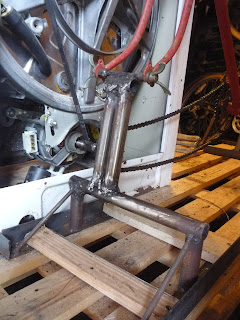Detailed step-by-step - How to make a viable spin dryer from a discarded washing machine drum, an abandoned bicycle and a pallet. After over a decade of doing our laundry with a home-made bicycle washing machine, we finally decided we needed the spin function too. With our 'new' spin dryer we can achieve a spin cycle of between 320 and 400 rpm which gives us 'non-drip' laundry, which we could never achieve with our bicycle washing machine.
At the end of the washing cycle, the water is drained out of the machine and to ensure that the water drains more freely, the drum is continually turned. As one pedals at low speed, you can feel the washing dropping down to the bottom of the drum, as you want it to do when washing. At slightly elevated pedaling speeds, the 'jerky' motion of the falling wet washing, ceases as the washing starts to stick to the drum wall due to the centripetal/centrifugal force.
Important - Units of Measurement
This is not a one-size-fits-all project, you have to reference your actual machine and all its component sizes (drain hose diameter, screw threads, etc.,) to the build. My machine being French, means all the threaded components are metric and I have also noted that some of the threaded bar/rod, sold in the US, for example, is now also in metric. So rather than my directly translating these dimensions into Imperial, which would not be appropriate, just substitute your machine's fastener sizes.
The Main Components
The Bicycle: These wonderful machines are very often discarded long before their useful life has ceased, so can be bought, very cheaply, from secondhand shops, yard sales and many other sources. Alternatively, one can just intercept them before they get thrown into the dumpster. In my case, items like these are 'fly-tipped' behind our village bottle-bank and it is always worth my checking occasionally to see if any have been left there. The one I'm using for this project is from this latter source and is a well-used Rolland (now Jacquot) of Versailles. The major components of this i.e. frame, crankset and rear wheel hub were still O.K. for my needs.
The Washing Machine Drum: An old top-loading model that was badly corroded around the base was given to me by a friend. The drum and drum housing, including the bearings were still serviceable.
The Pallet: A non-standard sized pallet long enough to fit the bicycle and the supported drum was selected. For the layout of my components the pallet size was: 135cm x 80cm (53" x 32").
Extra Materials
Stands - I used the metal ones I had created for a previous pedal-powered washing machine but at the end I'll post a link on how I make wooden ones from untreated pallet wood.
Pallet Wood Planks Various sizes and thicknesses
Nuts, Bolts and Washers to fit:
Threaded bar - with regard to sizes as detailed above, this will need to correspond to the existing threads on the washing machine.
Additional Bicycle Chain - approximately 10" (250mm)
Tools
All of this build can be achieved with hand tools but if you have them and the power to run them, then obviously it will be quicker if you use power tools for some of the build:
- taps and dies
- spanners
- screwdriver
- wood saw
- hacksaw
- vice
- angle grinder
- electric drill
- lathe (optional)
- tape measure
The Design
The criteria for making a successful spin-dryer was to be able to increase the drum rotation speed such that the wet contents of the drum would be forced against the drum wall by centrifugal/centripetal force and the water would pass through the perforated drum wall. The faster the spin speed the greater the force and hence the more water should be expressed out of the laundry. In addition, the duration of spin would also affect the water removal.
The position of the drum in relation to the bicycle was also an important consideration: whether the drum is in front of the bicycle or behind makes a difference to the overall pallet size and chain length. I had already found that the smallest footprint would be achieved with the drum in front of the pedals rather than behind.
The washing machine had a direct drive from the crankset to a chainwheel attached to the drum shaft. They were the same size and thus had a 1:1 gear ratio. For the new project I used the smallest gear from the rear wheel gear cluster on the drum shaft which would raise the ratio to 1:3.2. Initially I had thought of having the same 'fixed wheel' arrangement between bicycle and drum as on the washing machine (see above) but after a discussion with some undergrad students on design choices for the spin-dryer I decided to see if it were possible to use a freewheel hub instead.
The Build - The Gearing Cluster
As I mentioned earlier, the exterior housing of the washing machine was not in a sound state, so I removed the drum/pulley wheel assembly from it.
The first part of the build was to obtain the rear wheel cluster and hub from the bicycle. I clamped the wheel by its spindle in the vice and removed the spokes using a cutting disc in the angle grinder. The spokes from the wheel hub on the other side to the gear cluster were the first to be removed, allowing easier access for the cutting disc to those fixed nearest the cluster. Once all removed the last remaining portions of the spokes could be ground out from the rear of the hub.
I then needed the bearing and housing removed from the remainder of the rear wheel spindle housing. Once again using the cutting disc I removed the other end of the spindle housing which then enabled me to clamp it in the vice and cut the bearing and its housing from the rest with a hacksaw.
The bearing and housing fitted into the gear cluster and a 10mm threaded bar was used instead of the wheel spindle. Matching nuts either side of the cluster held the cluster securely in place.
The problem I was now faced with was, for the bicycle/drum configuration I had opted for, the hub would have to fit into the drum shaft with the smallest gear of the cluster nearest to the drum. This would still let me pedal in the conventional, cycling direction to turn the drum. The drum shaft was threaded at the end to accommodate an 8mm screw so I needed to reduce the threaded spindle from 10mm to 8mm and cut a new thread to fit.
I held the free end of the 10mm shaft in the chuck of my wood-turning lathe and reduced the shaft diameter using the angle grinder whilst the lathe was in motion. I had an 8mm washer as a go/no go gauge, checking the fit frequently to ensure I did not remove too much from the spindle diameter. Once I got my gauge washer to fit down the ground portion, I clamped the 10mm end of the shaft between two pieces of wood in the vice (to prevent damage to the thread), filed a chamfer on the free end of the 8mm section and cut the thread with an 8mm die.
The newly-made shaft could then be screwed into the drum shaft and the gear cluster secured to the 10mm portion of this shaft. A visual check was made to ensure the gear cluster was running concentrically with the drum shaftThe Build - Attaching the Bicycle
It was now time to attach the bicycle and the drum onto the pallet. The bicycle was supported on two axle stands that I had made for our original; pedal-powered washing machine. These were of welded construction. If I had not had these available, I would have made new ones using pallet wood:- see how to make these under Related Articles. The metal supports were fixed to the pallet using wood screws.
The Build - Attaching the Drum
The drum mounting was more difficult. As was explained at the beginning of this post, the housing of the machine was very badly corroded and could not be used. Thus I had to make wooden supports that could in turn be fixed to the pallet. The biggest problem with this was that there was no common datum on the bottom of the drum housing, in effect the drum if placed onto a flat level surface could not stand upright. In order to obtain a level across the three mounting points, I turned the drum over onto its lid, ensuring that the lid opening catch was not touching the workbench surface. The height difference between the mounting points could then be determined and wooden planks and spacers cut to the appropriate length and thickness and attached, using the original mounting bolts and nuts (recuperated). These supports were in turn screwed to the 'carrier' planks which were parallel to the drum axis, so as to fit across the pallet, next to the bicycle. These two 'carrier' planks were slotted, two slots per plank, the slots coincided with the approximate centre line of planks on the main pallet and with four holes drilled therein. Securing bolts and washers secured the drum to the pallet.
Drainage of water from the drum was as with the pedal washing machine via gravity. I had established that once the redundant pump assembly had been removed from the bottom of the drum, a conventional vacuum cleaner hose would fit neatly over the exit port where the pump had been attached.
At this stage of the construction, I was still unsure as to how much additional bracing would be needed in order to hold the drum steady at the elevated speeds of spinning. As a provisional measure, I took advantage of four moulded stubs integral to the drum housing, these originally held the shock- absorbers. Down the centre of each stub I drilled a hole and then tapped it to 6mm. I then attached planks which spanned the pairs of stubs on each side of the drum housing using 6mm bolts.
Now the drum was fixed to the pallet, I could extend and attach the chain from the bicycle to the smallest gear of the cluster on the drum shaft. It is possible to ensure the chain is running straight between the two sets of gears simply by looking along the faces of the two gear sprockets (driving and driven). Optimum chain tension and alignment was attained by moving the drum assembly on its slotted mounting holes prior to tightening the mounting bolts.
Test Run
Once the bicycle and drum were connected, a quick pedal with the drum empty established that there were no problems with alignment and chain tension. So it was then time for the acid test.
Wet washing was transferred from the washing machine into the spin dryer and the lid closed. The starting load on the pedals was noticeably higher compared to the lower 1:1 gear ratio of the washing machine but it was not difficult to set the drum in motion. Slowly accelerating it became apparent that for what seemed a relatively slow pedal speed, water was exiting rapidly from the drain tube. Accelerating further the water flow increased and then as the contents became drier, diminished. Timing my pedaling speed I determined that the drum spin speed was about 350 rpm which could be maintained for at least a couple of minutes until the water flow was nil. Letting the drum freewheel to a halt, the contents were examined and were definitely much drier, to the extent that no further water could be extracted when it was attempted to wring it by hand.
Here's the film to see it in action:
Improvements
The first thing that would improve the spin dryer will be to obtain another top loading machine and keep the drum in its original housing. This would obviate the need of making elaborate supports to hold the drum level and steady.
Secondly I think that the drive to the drum should be direct i.e. not freewheel. This I believe will enable the 'cyclist' to rotate the drum in both directions at the start of the spin-cycle to distribute the wet contents evenly within the drum and thus prevent the need to stop spinning to even the load in the drum.
Hope you enjoyed this project and much as we do having non-drip washing! If you read this article and found it interesting then share it with your friends on social media or suchlike. Please also feel free to ask questions and or make comments and if you found this helpful and would like to support this site you can always ![]()
© Andy Colley 2022


























